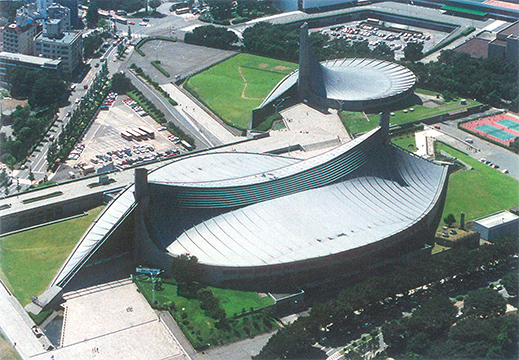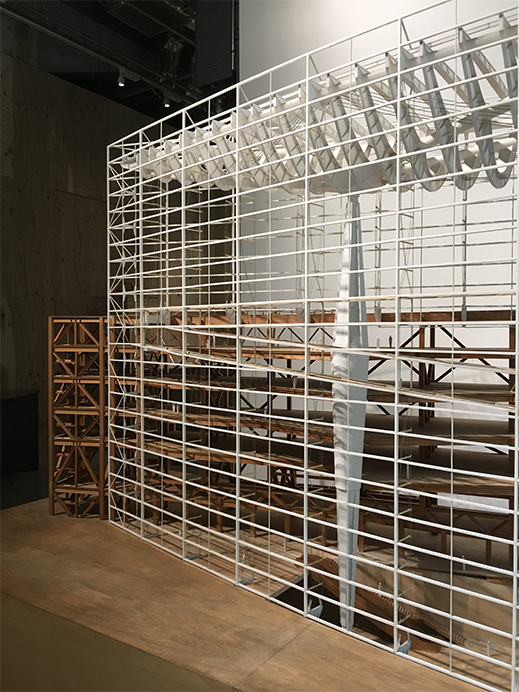 |
Focus features two in-depth reviews each month of fine art, architecture and design exhibitions and events at art museums, galleries and alternative spaces around Japan. The contributors are non-Japanese residents of Japan. |
|
|
 |
 |
 |
A View on Structure: Highlighting the Critical Role of Structural Engineers in Japan's Iconic Buildings
James Lambiasi |
 |
Exhibition view, Structural Engineers -- The Sense of Structural Design, Archi-Depot Museum. Photo: Kenji Seo
|
When I meet someone while traveling abroad and I mention that I am an architect practicing in Japan, there is one reaction that I receive more than any other: "With the earthquakes in Japan, you must be very knowledgeable about structures." To this comment my response is consistent. I explain quite frankly that I am not particularly knowledgeable, as I rely on collaboration with extremely talented structural engineers.
The perception that a building design is the direct result of an architect's decisions is pervasive, while in fact architectural design is the result of combined knowledge from a broad array of specialists collaborating together. With this in mind, Archi-Depot Museum has admirably placed the spotlight on the unsung heroes responsible for some of the most significant buildings in Japan's modern history. Structural Engineers -- The Sense of Structural Design, the museum's current exhibition, highlights the work of 50 structural engineers in Japan from the 1950s to the present.
 |
|
Yoshikatsu Tsuboi / Yoyogi National Stadium. Photo: Masao Saito |
Mutsuro Sasaki / Sendai Mediatheque axonometric. Image provided by Sasaki and Partners |
Perhaps one of the most iconic examples of engineering in modern architecture is the Yoyogi National Stadium, which is a collaboration between structural engineer Yoshikatsu Tsuboi and architect Kenzo Tange for the 1964 Tokyo Olympic Games. Using a cable tensile structure to gracefully span the expanse of the gymnasium space, this building crystallized a seminal moment that put Japan on the world stage of architecture. In 2001, a more recent milestone was achieved in Sendai Mediatheque by structural engineer Mutsuro Sasaki and architect Toyo Ito. The remarkable feature of Sendai Mediatheque is its vertical structure system of steel pipes, which read as continuous mesh-like tubes. With the floors made of a consistently thin honeycomb structure, the result is a series of stacked floors that seem to float in air.
Ryozo Umezawa / Iron House, steel model, scale 1/30. Photo: Kenji Hagio |
Ryozo Umezawa / Iron House, mock-up (sandwich panel), scale 1/1. Photo: James Lambiasi |
The exhibition is an unprecedented collection of materials that convey the critical role of structural engineers in the building process. Exhibits include models, drawings, sketches, and video interviews, which explain in detail the innovations of each structural design. Iron House, by structural engineer Ryozo Umezawa, is represented beautifully by a model made entirely of steel, and photos depict the mysterious interior of this building which consists entirely of steel structural elements. Detail mock-up exhibits provide further understanding of the structure, for example of its composite sandwich panel system.
Hirokazu Toki / Three-way lattice mock-up. Photo: James Lambiasi
|
|
 |
|
|
|
Kunio Watanabe / Tokyo International Forum, structural model, scale 1/40. Photo: James Lambiasi |
Each of the 70 exhibits provides a new and fascinating perspective from which to perceive each building. Hirokazu Toki is known for his use of the traditional Japanese wood detail sanpo koshi, a three-way lattice connection shown by a mock-up available for close examination. The cavernous space of the Tokyo International Forum is famous for its whale-like roof structure, which is supported by a mere two columns. The detail of the exhibited model makes clear the way in which all of these elements have been configured by structural engineer Kunio Watanabe.
The creation of such an unprecedented show highlighting the work of Japan's foremost structural engineers can be attributed to the extremely unique origins of Archi-Depot Museum. Initially established to function as a warehouse for architectural models, the facility is run by a corporation whose innovative thinking has brought these valuable models into public view. Today, as a museum, it continues to spur creative dialogue though thought-provoking exhibitions and events.
All images are shown by permission of Archi-Depot Museum. |
 |
 |
James Lambiasi
Following completion of his Master's Degree in Architecture from Harvard University Graduate School of Design in 1995, James Lambiasi has been a practicing architect and educator in Tokyo for over 20 years. He is the principal of his own firm James Lambiasi Architect, has taught as a visiting lecturer at several Tokyo universities, and has lectured extensively on his work. James served as president of the AIA Japan Chapter in 2008 and is currently the director of the AIA Japan lecture series that serves the English-speaking architectural community in Tokyo. He blogs about architecture at tokyo-architect.com. |
|
 |
|